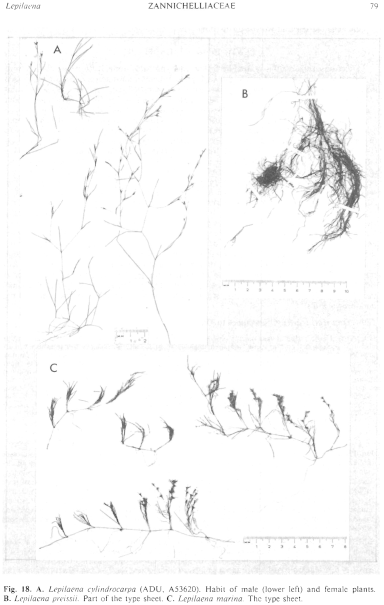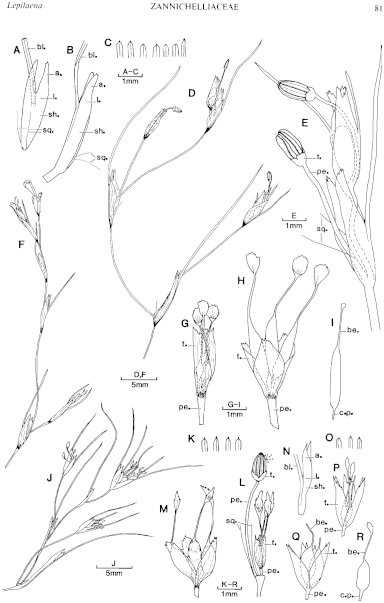|
|
|
|
|
|||||||||||
|
Electronic Flora of South Australia Species Fact Sheet
Phylum Magnoliophyta – Subphylum Seagrasses – Class Liliopsida – Subclass Alismatidae – Order Potamogetonales – Family Zannichelliaceae
Selected citations: Aston 1973: 316, Fig. 129. Green 1981: 5. Jessop 1978: 76. Willis 1970: 70.
Synonyms
Zannichellia cylindrocarpa Koernicke in Walpers 1861: 3.
Althenia cylindrocarpa (Koernicke in Walpers) Ascherson 1889: 213.
Dioecious in marine specimens examined (Fig. 18A); herb, probably annual. Rhizomes 0.3–0.5 mm in diameter with an amplexicaul scale 1–5 mm long at each node, and usually at every alternate node 1–4 roots and an erect shoot 5–15 (–25) cm tall. Leaf sheath (Fig. 19A,B) inflated, membranous, 4–6 mm long, ligule 1–2 mm long mostly deeply cleft; blade linear, 2–8 cm long, 0.1–0.2 (–0.3) mm broad; apex (Fig. 19C), acute to acuminate or tapering to a very short mucro. Squamules (Fig. 19A,B), filiform, mostly about 2 mm long, sometimes projecting from the sheath (Fig. 19D,E). Male flowers (Figs 18A, 19D,E) on slender flexuous, branched shoots 15–35 cm tall, borne singly on very short pedicels, at first enclosed within the inflated leaf sheath; tepals minute, united into a cup; stamen with 6 pollen sacs, 1.2–1.6 mm long; at anthesis the pedicel elongates to about 1 cm long and carries the flower well beyond the leaf sheath. Female flowers (Figs 18A, 19F,G) on slender flexuous branched shoots 15–25 cm tall, on pedicels 5–10 mm long frequently elongating in the fruit to about 2 cm, to project the mature achenes well beyond the leaf sheath; tepals 2.5–4 mm long, membranous, ovate-lanceolate, apex serrate; carpophore 0.5–1 mm long, sometimes elongating in the fruit to 3–4 mm long, style 2–3 mm long, stigma narrow, obliquely funnel-shaped with an irregularly serrate margin, ovary at first enclosed within the tepals but after fertilisation enlarging considerably to project well beyond them (Fig. 19H). Fruit (Fig. 19H,I) an achene, dark-brown, cylindrical, 2.0–3.0 mm long, usually L/B 3–4 (–6).
Type from "Australia felix"*F. Mueller n. 52 (Herb. Berlin-presumed destroyed).
Selected specimens: Inman River mouth, Encounter Bay, S. Aust., in brackish water billabong (Skinner, 2.x.1978; ADU, A49572). Camp Noonameena, North Lagoon, Coorong, S. Aust., 0.5 m deep, in mud (Robertson, 18.ix.1982; ADU, A53620). Coorong, S. Aust. salinity 50–58‰ (Snoejs & van der Ster, 29.xii.1980; ADU, A53214). Yarra River delta, Victoria (Clifford, 1.ix.1948; MEL, 578049).
Distribution: In marine estuaries around southern Australia from the Inman R. estuary, Encounter Bay, S. Aust. to Yarra R. estuary, Vic., and in the North Lagoon, Coorong, S. Aust. which is influenced by tides but not exposed to open seas. Also in fresh to brackish to saline inland waters, in swamps and lakes.
Taxonomic notes: * "Australia felix" was used broadly to denote the area of grasslands and coastline of southern Victoria from Melbourne westwards to Portland.
References:
ASCHERSON, P. (1889). Potamogetonaceac. In Die natürlichen Pflanzenfamilien. (ed. A. Engler & K. Prantl) Teil 2, 1. 173–240. (W. Engelmann: Leipzig.)
ASTON, H. (1973). Aquatic plants of Australia. (Melbourne University Press: Melbourne.)
BENTHAM, G. (1878). Flora Australiensis: A Description of the Plants of the Australian Territory. Vol. 7. (Reeve: London.)
GREEN, J.W. (1981). Census of the Vascular Plants of Western Australia. (Western Australian Herbarium: South Perth.)
JESSOP, J.P. (1978). J.M. Black's Flora of South Australia. 3rd edn. Part I. (Govt. Printer: Adelaide.)
WILLIS, J.H. (1970). A handbook to plants in Victoria. Vol. 1. 2nd edn. (Melbourne University Press: Melbourne.)
The Marine Benthic Flora of Southern Australia Part I complete list of references.
Publication:
Womersley, H.B.S. (31 May, 1984)
The Marine Benthic Flora of Southern Australia
Part I
©Board of the Botanic Gardens and State Herbarium, Government of South Australia
Illustrations in Womersley Part I, 1984: FIGS 18A, 19 A–I.

Figure 18 enlarge
Fig. 18. A. Lepilaena cylindrocarpa (ADU, A53620). Habit of male (lower left) and female plants. B. Lepilaena preissii. Part of the type sheet. C. Lepilaena marina. The type sheet.

Figure 19 enlarge
Fig. 19. A–I. Lepilaena cylindrocarpa (ADU, A53620). A. Portion of leaf (adaxial view) showing blade (bl.) and sheath (sh.) junction. Note ligule (l.) deeply cleft into 2 auricles (a.) and a pair of squamules (sq.) adhering to the sheath base. B. Junction of leaf blade and sheath (side view) showing ligule (l.), auricles (a.) and squamules (sq.). C. Leaf apices. D. Portion of male inflorescence. E. Portion of male inflorescence showing 3 male flowers, lowest (oldest) with dehisced pollen sacs, mature flower with ripe pollen sacs and immature flower enclosed in sheath. Note pedicel (pe.), pollen sacs, tepals (t.) and squamules (sq.). F. Portion of female inflorescence. G. Young female flower showing pedicel (pe.) and tepals (t.) enclosing the carpels with styles projecting. H. Mature fruit showing 3 achenes projecting beyond tepals. 1. Mature achene. Note carpophore (c.p.) and stylar beak (be.).
J–M. Lepilaena preissii (ADU, A53395). J. Portion of monoecious plant with inflorescence. K. Leaf apices. L. A mature male and an immature female flower in position, subtending leaves removed. Note squamules (sq.), tepals (t.) and pedicels (pe.). M. Mature fruit showing 3 achenes enclosed within the tepals. N–R. Lepilaena preissii (Type specimen). N. Junction of leaf blade (bl.) and sheath (sh.) showing ligule (l.) and auricles (a.). 0. Leaf apices. P. Female flower (two stigmas damaged, one missing), with pedicel (pe.) and tepals (t.). Q. Mature fruit showing achenes enclosed within tepals (t.). R. Single achene showing stylar beak (be.) and carpophore (c.p.).

|
Email Contact: State Herbarium of South Australia |

|